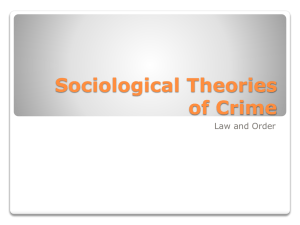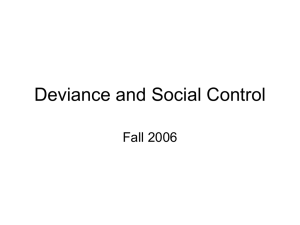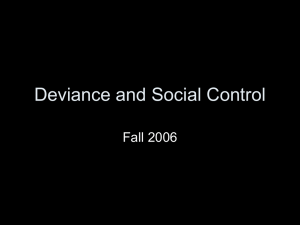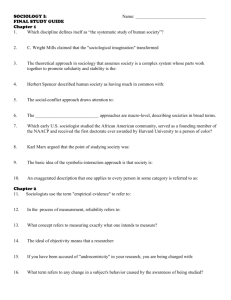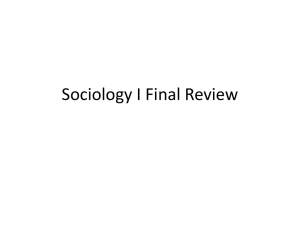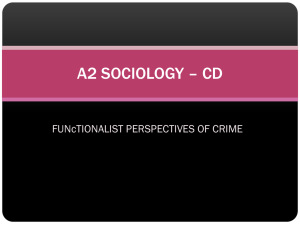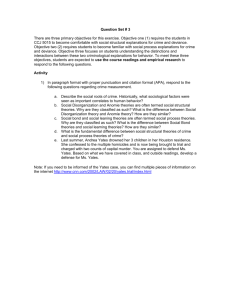here
advertisement
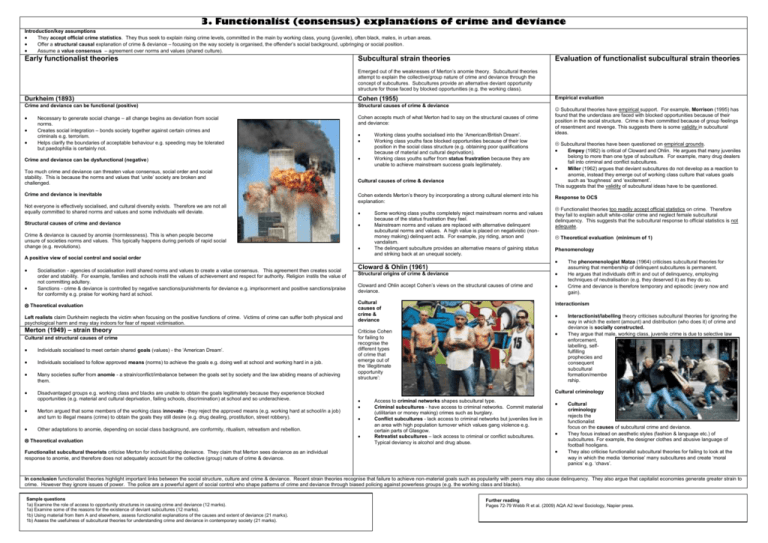
3. Functionalist (consensus) explanations of crime and deviance Introduction/key assumptions They accept official crime statistics. They thus seek to explain rising crime levels, committed in the main by working class, young (juvenile), often black, males, in urban areas. Offer a structural causal explanation of crime & deviance – focusing on the way society is organised, the offender’s social background, upbringing or social position. Assume a value consensus – agreement over norms and values (shared culture). Early functionalist theories Subcultural strain theories Evaluation of functionalist subcultural strain theories Emerged out of the weaknesses of Merton’s anomie theory. Subcultural theories attempt to explain the collective/group nature of crime and deviance through the concept of subcultures. Subcultures provide an alternative deviant opportunity structure for those faced by blocked opportunities (e.g. the working class). Empirical evaluation Durkheim (1893) Cohen (1955) Crime and deviance can be functional (positive) Structural causes of crime & deviance Cohen accepts much of what Merton had to say on the structural causes of crime and deviance: Necessary to generate social change – all change begins as deviation from social norms. Creates social integration – bonds society together against certain crimes and criminals e.g. terrorism. Helps clarify the boundaries of acceptable behaviour e.g. speeding may be tolerated but paedophilia is certainly not. Working class youths socialised into the ‘American/British Dream’. Working class youths face blocked opportunities because of their low position in the social class structure (e.g. obtaining poor qualifications because of material and cultural deprivation). Working class youths suffer from status frustration because they are unable to achieve mainstream success goals legitimately. Crime and deviance can be dysfunctional (negative) Too much crime and deviance can threaten value consensus, social order and social stability. This is because the norms and values that ‘unite’ society are broken and challenged. Cultural causes of crime & deviance Crime and deviance is inevitable Cohen extends Merton’s theory by incorporating a strong cultural element into his explanation: Not everyone is effectively socialised, and cultural diversity exists. Therefore we are not all equally committed to shared norms and values and some individuals will deviate. Structural causes of crime and deviance Crime & deviance is caused by anomie (normlessness). This is when people become unsure of societies norms and values. This typically happens during periods of rapid social change (e.g. revolutions). A positive view of social control and social order Socialisation - agencies of socialisation instil shared norms and values to create a value consensus. This agreement then creates social order and stability. For example, families and schools instil the values of achievement and respect for authority. Religion instils the value of not committing adultery. Sanctions - crime & deviance is controlled by negative sanctions/punishments for deviance e.g. imprisonment and positive sanctions/praise for conformity e.g. praise for working hard at school. Theoretical evaluation Left realists claim Durkheim neglects the victim when focusing on the positive functions of crime. Victims of crime can suffer both physical and psychological harm and may stay indoors for fear of repeat victimisation. Merton (1949) – strain theory Cultural and structural causes of crime Individuals socialised to meet certain shared goals (values) - the ‘American Dream’. Individuals socialised to follow approved means (norms) to achieve the goals e.g. doing well at school and working hard in a job. Many societies suffer from anomie - a strain/conflict/imbalance between the goals set by society and the law abiding means of achieving them. Disadvantaged groups e.g. working class and blacks are unable to obtain the goals legitimately because they experience blocked opportunities (e.g. material and cultural deprivation, failing schools, discrimination) at school and so underachieve. Merton argued that some members of the working class innovate - they reject the approved means (e.g. working hard at school/in a job) and turn to illegal means (crime) to obtain the goals they still desire (e.g. drug dealing, prostitution, street robbery). Other adaptations to anomie, depending on social class background, are conformity, ritualism, retreatism and rebellion. Theoretical evaluation Functionalist subcultural theorists criticise Merton for individualising deviance. They claim that Merton sees deviance as an individual response to anomie, and therefore does not adequately account for the collective (group) nature of crime & deviance. Some working class youths completely reject mainstream norms and values because of the status frustration they feel. Mainstream norms and values are replaced with alternative delinquent subcultural norms and values. A high value is placed on negativistic (nonmoney making) delinquent acts. For example, joy riding, arson and vandalism. The delinquent subculture provides an alternative means of gaining status and striking back at an unequal society. Subcultural theories have empirical support. For example, Morrison (1995) has found that the underclass are faced with blocked opportunities because of their position in the social structure. Crime is then committed because of group feelings of resentment and revenge. This suggests there is some validity in subcultural ideas. Subcultural theories have been questioned on empirical grounds. Empey (1982) is critical of Cloward and Ohlin. He argues that many juveniles belong to more than one type of subculture. For example, many drug dealers fall into criminal and conflict subcultures. Miller (1962) argues that deviant subcultures do not develop as a reaction to anomie, instead they emerge out of working class culture that values goals such as ‘toughness’ and ‘excitement’. This suggests that the validity of subcultural ideas have to be questioned. Response to OCS Functionalist theories too readily accept official statistics on crime. Therefore they fail to explain adult white-collar crime and neglect female subcultural delinquency. This suggests that the subcultural response to official statistics is not adequate. Theoretical evaluation (minimum of 1) Phenomenology Cloward & Ohlin (1961) The phenomenologist Matza (1964) criticises subcultural theories for assuming that membership of delinquent subcultures is permanent. He argues that individuals drift in and out of delinquency, employing techniques of neutralisation (e.g. they deserved it) as they do so. Crime and deviance is therefore temporary and episodic (every now and gain). Structural origins of crime & deviance Cloward and Ohlin accept Cohen’s views on the structural causes of crime and deviance. Cultural causes of crime & deviance Interactionism Criticise Cohen for failing to recognise the different types of crime that emerge out of the ‘illegitimate opportunity structure’: Interactionist/labelling theory criticises subcultural theories for ignoring the way in which the extent (amount) and distribution (who does it) of crime and deviance is socially constructed. They argue that male, working class, juvenile crime is due to selective law enforcement, labelling, selffulfilling prophecies and consequent subcultural formation/membe rship. Cultural criminology Access to criminal networks shapes subcultural type. Criminal subcultures - have access to criminal networks. Commit material (utilitarian or money making) crimes such as burglary. Conflict subcultures - lack access to criminal networks but juveniles live in an area with high population turnover which values gang violence e.g. certain parts of Glasgow. Retreatist subcultures – lack access to criminal or conflict subcultures. Typical deviancy is alcohol and drug abuse. Cultural criminology rejects the functionalist focus on the causes of subcultural crime and deviance. They focus instead on aesthetic styles (fashion & language etc.) of subcultures. For example, the designer clothes and abusive language of football hooligans. They also criticise functionalist subcultural theories for failing to look at the way in which the media ‘demonise’ many subcultures and create ‘moral panics’ e.g. ‘chavs’. In conclusion functionalist theories highlight important links between the social structure, culture and crime & deviance. Recent strain theories recognise that failure to achieve non-material goals such as popularity with peers may also cause delinquency. They also argue that capitalist economies generate greater strain to crime. However they ignore issues of power. The police are a powerful agent of social control who shape patterns of crime and deviance through biased policing against powerless groups (e.g. the working class and blacks). Sample questions 1a) Examine the role of access to opportunity structures in causing crime and deviance (12 marks). 1a) Examine some of the reasons for the existence of deviant subcultures (12 marks). 1b) Using material from Item A and elsewhere, assess functionalist explanations of the causes and extent of deviance (21 marks). 1b) Assess the usefulness of subcultural theories for understanding crime and deviance in contemporary society (21 marks). Further reading Pages 72-79 Webb R et al. (2009) AQA A2 level Sociology, Napier press.
